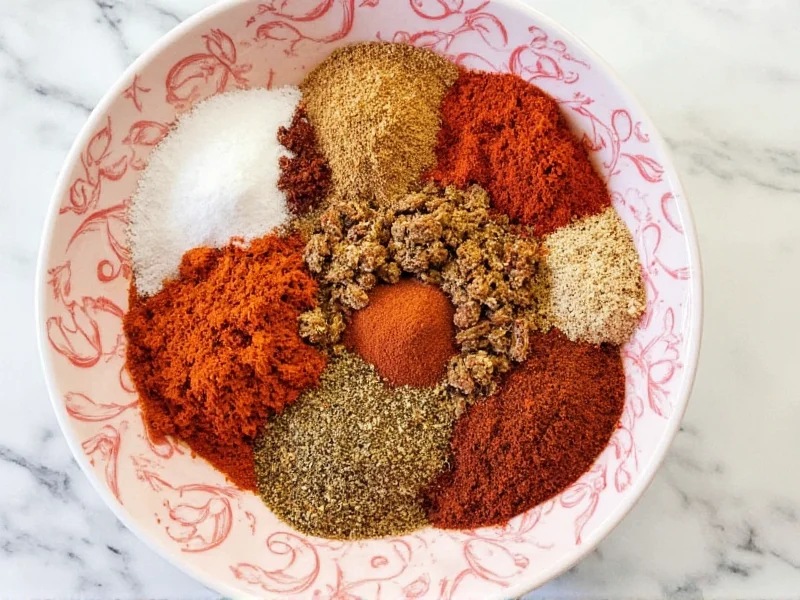Understanding which spices enhance pork's natural flavor profile is essential for creating memorable dishes. Pork's mild sweetness and fat content provide an ideal canvas for both bold and subtle seasonings. The right spice combination can transform ordinary pork cuts into extraordinary meals, whether you're preparing a quick weeknight dinner or special occasion feast.
The Science Behind Pork and Spice Pairing
Pork contains natural sugars that caramelize beautifully when cooked, creating a flavor foundation that pairs exceptionally well with both earthy and aromatic spices. The fat content in pork acts as a flavor carrier, allowing spices to penetrate deeply and distribute their essence throughout the meat.
When selecting spices for pork, consider these key principles:
- Balance - Pair strong spices with complementary milder ones
- Texture - Coarse rubs work better for thicker cuts, fine grinds for quick-cooking pieces
- Timing - Salt early, add delicate herbs near the end of cooking
- Regional authenticity - Traditional pairings often reflect centuries of culinary refinement
Best Spices for Specific Pork Cuts
Different pork cuts require tailored seasoning approaches based on their fat content, texture, and cooking method. Understanding these distinctions helps you select the most effective spices for pork chops, shoulder, tenderloin, and other popular cuts.
| Pork Cut | Recommended Spices | Application Method |
|---|---|---|
| Pork Chops | Garlic powder, smoked paprika, thyme, black pepper | Rub directly on meat 30 minutes before cooking |
| Pork Shoulder | Cumin, coriander, chili powder, brown sugar | Generous rub applied overnight before slow cooking |
| Tenderloin | Rosemary, sage, garlic, Dijon mustard base | Marinate 2-4 hours before roasting |
| Pulled Pork | Onion powder, cayenne, allspice, mustard powder | Incorporate into dry rub and finishing sauce |
| Bacon | Maple sugar, coffee, black pepper, smoked paprika | Apply to uncured pork belly before smoking |
Regional Spice Blends for Pork
Cultural traditions have developed distinctive spice combinations that highlight pork's versatility across global cuisines. These traditional pork seasoning ideas reflect generations of culinary refinement.
Mediterranean Herb Profile
The classic combination of rosemary, thyme, garlic, and olive oil creates a bright, aromatic profile perfect for pork tenderloin or chops. Add lemon zest for extra brightness in this traditional pork rub recipe that works beautifully with quick-cooking cuts.
Asian Five-Spice Fusion
Chinese five-spice powder (star anise, cloves, Chinese cinnamon, Sichuan pepper, and fennel seeds) offers a complex sweet-spicy profile ideal for pork belly and ribs. For authentic Asian pork seasoning, combine with soy sauce, ginger, and a touch of honey for glazes.
American BBQ Rubs
Traditional Southern pork rubs typically feature paprika, brown sugar, garlic powder, onion powder, and cayenne. The best spices for pulled pork include additional elements like coffee grounds and mustard powder that complement slow-cooked preparations. Adjust sugar content based on cooking method—less sugar for long smokes to prevent burning.
Latin American Adobo
Cumin, oregano, garlic, and citrus create vibrant profiles for carnitas and other Latin pork dishes. For authentic pork shoulder seasoning, include achiote for color and subtle earthiness in your spice blend for pulled pork.
Creating Your Own Custom Pork Seasoning Mix
Developing personalized spice blends for pork allows you to tailor flavors to your specific preferences. Follow this framework when experimenting with homemade pork seasoning mix recipes:
- Base (40%) - Salt and sugar components that form the foundation
- Aromatics (30%) - Garlic, onion, ginger that provide immediate flavor impact
- Primary spices (20%) - The dominant flavor elements like paprika or cumin
- Accent spices (10%) - Subtle enhancers like allspice or mustard powder
When developing your own best spices for pork chops or other cuts, remember that fat-soluble spices (like paprika and cumin) benefit from being applied early, while water-soluble compounds (like certain herbs) work better added toward the end of cooking.
Common Spice Pairing Mistakes to Avoid
Even experienced cooks sometimes make errors when seasoning pork. Watch for these common pitfalls:
- Over-salting - Pork already contains natural sodium; be measured with additional salt
- Mismatched intensity - Delicate spices get overwhelmed on fatty cuts
- Ignoring cooking method - Sugar-heavy rubs burn during high-heat cooking
- Not considering accompaniments - Balance your pork seasoning ideas with planned side dishes
Spice Storage for Optimal Flavor
Fresh spices make the difference between good and exceptional pork dishes. Store whole spices in airtight containers away from light and heat, grinding them just before use. Ground spices lose potency within 6 months, while whole spices remain flavorful for up to 2 years. For the most vibrant herbs that go well with pork, consider growing your own rosemary, thyme, and sage for peak freshness.











 浙公网安备
33010002000092号
浙公网安备
33010002000092号 浙B2-20120091-4
浙B2-20120091-4